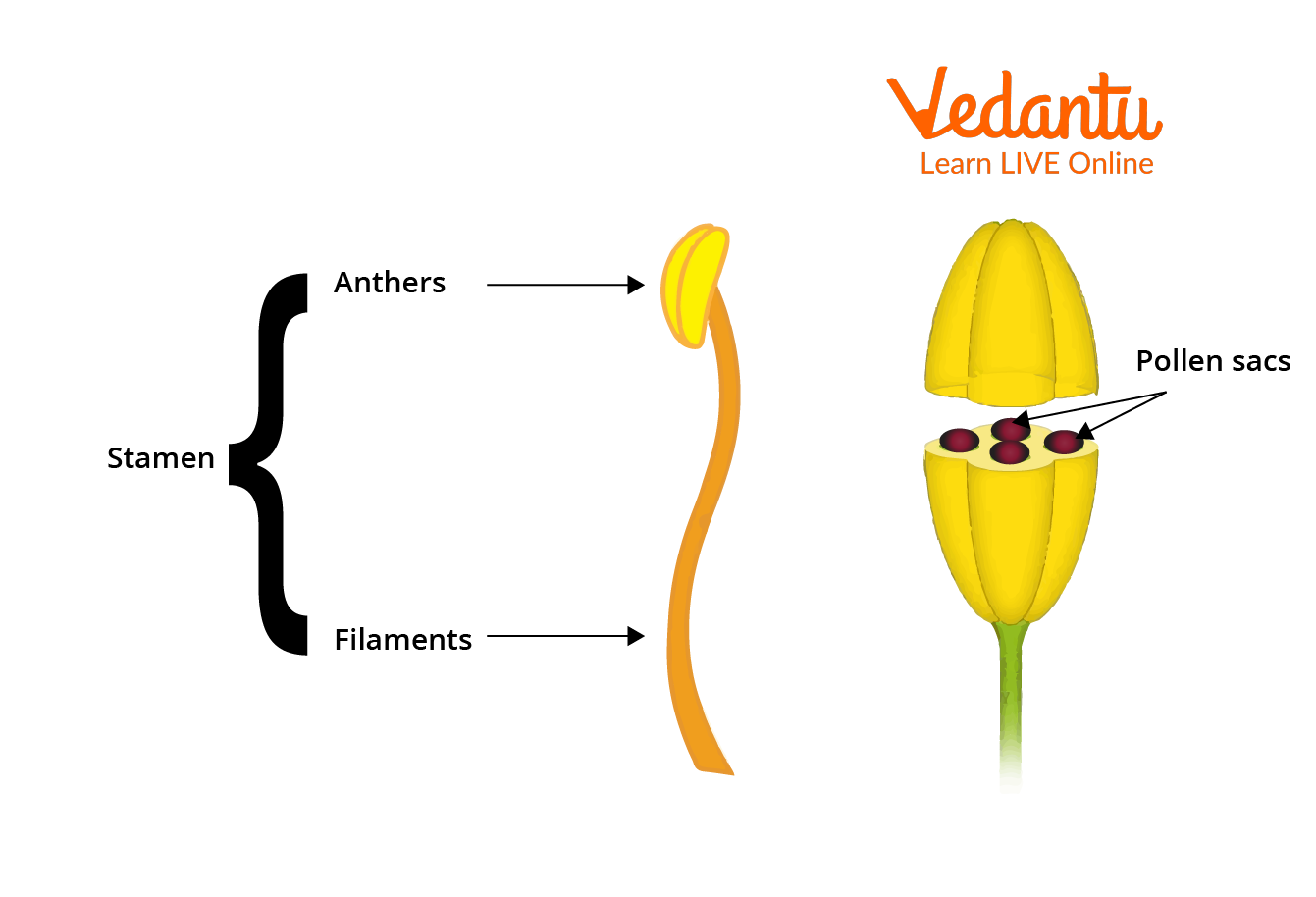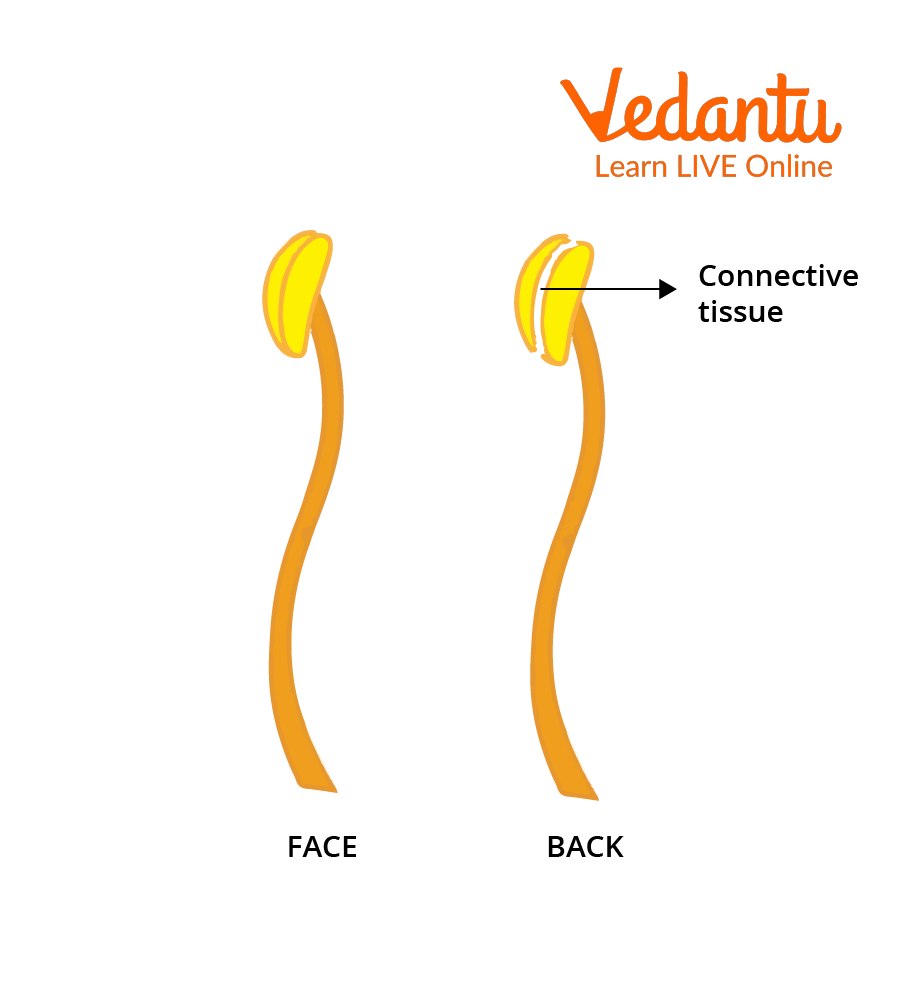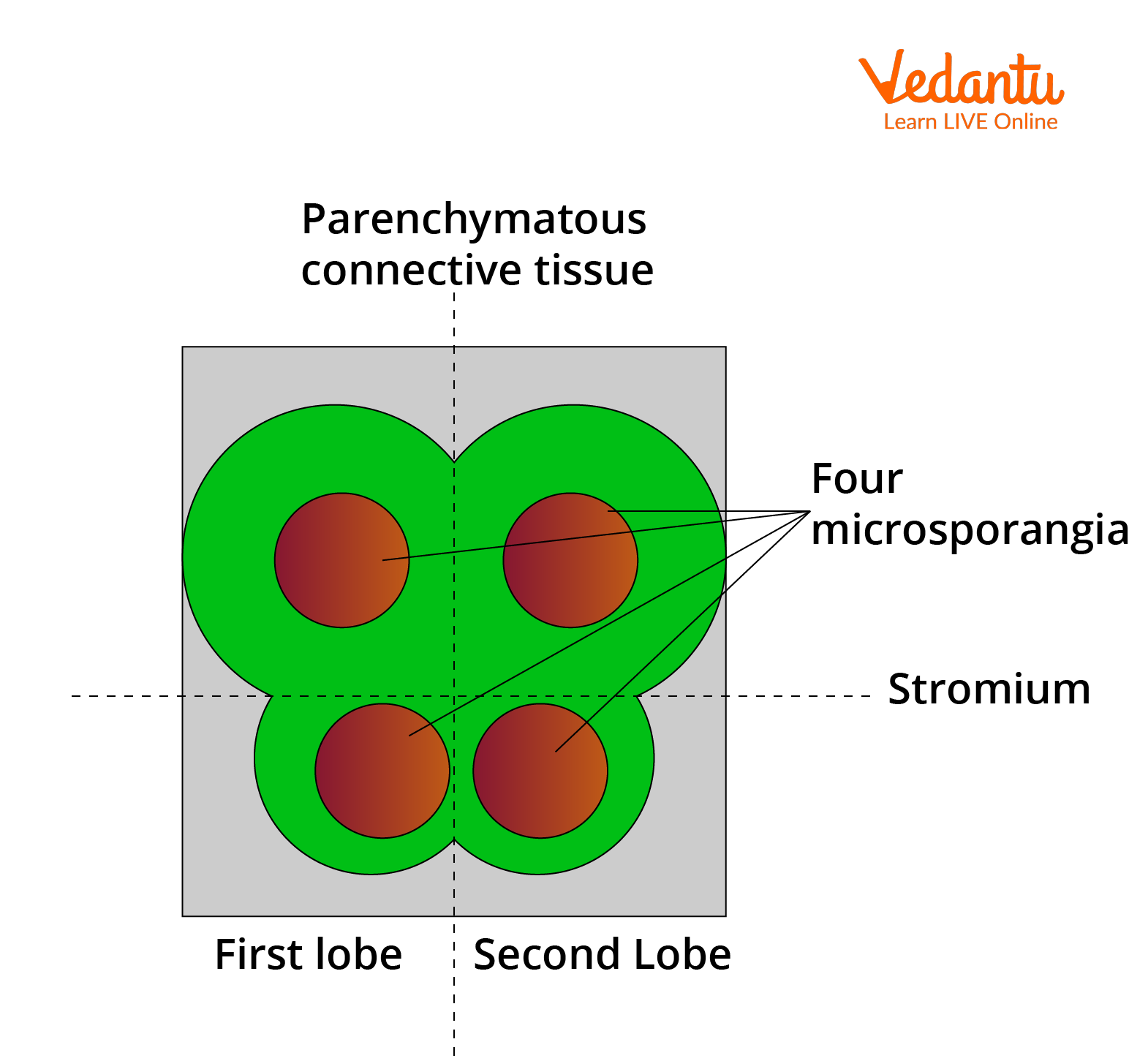Why Is the Stamen Important in Plant Reproduction?
A stamen is a reproductive structure found in flowering plants. A flower's biological function is to aid reproduction, usually by providing a mechanism for the union of sperm and eggs. Stamens are flowering plants' male reproductive organs. They are made up of an anther, which is the site of pollen development, and a stalk-like filament, which transmits water and nutrients to the anther and positions it to aid in pollen dispersal. The pistil is the female part and is typically found in the centre of the flower and consists of three parts: the stigma, style, and ovary.
In this article, we will have a look inside the male part of the flower and its structure and function.
What is Stamen?
The stamen is a flower's pollen-producing reproductive organ.
The androecium is made up of stamens.
Parts of a stamen include anther and filaments.
Anther is a yellowish sac-like structure that produces and stores pollen.
Filament is a thin, threadlike object that serves as a support for the anther.
A flower that has sepals, petals, stamens and pistils is said to be complete; a flower that lacks one or more of these structures is said to be incomplete.
Stamens and pistils are not found in all flowers. When both are present, the flower is said to be perfect, or bisexual, regardless of any other missing component.
Structure of Stamen

Structure of Stamen
Stamen structure is made up of anther and filament.
Anthers have a bilobed structure that transports pollen grains in pollen sacs.
Connective tissue connects both lobes of the anther.
A stamen filament emerges from the thalamus or peduncle, giving rise to a knob-like anther.
Anther shapes are differently portrayed by terms. For example: linear, rounded, sagittate, twisted or reniform.
Each lobe contains two thecae, indicating that an anther is dithecous.

External View of Anther
The internal structure of the anther has four chambers, which are separated by an external longitudinal groove called the stromium.

Internal Structure of Anther
The filament is the thin stalk that upholds the anther in the male part of the flower.
Filament carries the nutrients to the anther for pollen development.
Functions of Stamen
The primary capability of the stamen of a flower is to deliver the pollen grains, which house male gametes, or sex cells and are fundamental for a generation.
The anther is situated inside the stamen where these gametes are made.
Pollen grains fluctuate in size, shape and surface designs in view of the sort of flower that produces them.
Most pollen grains are round or oval and are exceptionally little.
The filament might be considered as only a straightforward tail. It has a vital capability.
The filament is liable for getting the pollen-bearing anther near the highest point of the pistil as conceivable on the grounds that here, pollen will be moved to the female conceiving organ.
The filament is ordinarily tall, and there are a significant number of them planned in a circle around the pistil to improve the probability of pollen transfer.
Types of Stamen
Polyandrous: In this kind, the filaments are not combined, they are free. Example: Lotus and Rose.
Monadelphous: In this condition, anthers are free and filaments are fused. Example: China Rose.
Diadelphous: Here, anthers are free but the filaments are fused in groups of two. Example: Pea.
Polyadelphous: Here anthers are still free, but the filaments are grouped together in more than two groups. Example: Citrus plants.
Syngenesious: Here, filaments are free and anthers are fused. Example: Marigold and Sunflower.
Synandrous: In this condition, all the anthers and filaments are fused together. Example: Cucurbita.
Some Terminologies Related to Stamen
On the Basis of Their Length
Didymous: Both the lengths are the same.
Didynamous: When they occur in two sets of a long pair and a short pair.
Tetradynamous: When they are present as a bunch of six stamens with four long and two short ones.
On the Basis of the Attachment of Anther and Filaments
Basifixed: It is the condition in which filaments are attached to the base of the anther.
Dorsifixed: In this condition, the filament is arranged on only the dorsal side of the anther.
Adnate: In this condition, filament runs through the whole length of the anther, from the base to the top.
Adaptable: In this condition, the filament is only attached to the middle of the anther.
Conclusion
The name of the stamen comes from the Latin word stare, which means "to stand." In ancient Rome, stamen also referred to the warp or thread of an upright loom. Flowers have more stamen than pistils because they produce billions of grains of pollen, the majority of which will never reach another plant's pistil.
The stamens structure the whorl just inside the corolla. Every stamen has a thin tail, or filament, at the highest point of which is an anther, the pollen-bearing organ. The whorl or gathering of stamens is known as the androecium, and this comprises the male piece of the flower. Floral parts of the plant and morphology of the plant cover a large portion of the examination, and the terminologies related to the stamen are also asked by the examiner frequently.


FAQs on What Is a Stamen? Structure, Function, and Types
1. What is a stamen and what is its primary function in a flower?
The stamen is the male reproductive organ of a flower. Its primary function is to produce and release pollen grains, which contain the male gametes necessary for fertilisation. The entire whorl of stamens in a flower is collectively known as the androecium.
2. What are the two main parts of a stamen and what role does each part play?
A typical stamen is composed of two main parts:
- The anther: This is a bilobed, sac-like structure at the tip of the stamen. It is responsible for producing and storing the pollen grains.
- The filament: This is the slender, stalk-like structure that supports the anther and connects it to the base of the flower (thalamus or petal).
3. What are the key differences between the stamen and the pistil?
The primary difference is that the stamen is the male reproductive part of a flower, while the pistil (or carpel) is the female reproductive part. Other key differences include:
- Components: A stamen consists of an anther and a filament, whereas a pistil is made up of a stigma, style, and ovary.
- Gametes: The stamen produces pollen grains which contain male gametes. The pistil contains ovules, which house the female gamete (egg).
- Function in Pollination: The stamen releases pollen, while the pistil's stigma is adapted to receive it.
4. How is the structure of an anther adapted for pollen dispersal?
The anther's structure is highly specialised for protecting, developing, and dispersing pollen. Typically, it is bilobed, with each lobe containing two pollen sacs (microsporangia). Within these sacs, pollen grains develop. Upon maturity, a layer of cells in the anther wall, the endothecium, helps in the splitting (dehiscence) of the anther along a line of weakness to release the vast number of pollen grains for pollination.
5. What is the importance of the filament's length and flexibility?
The length and flexibility of the filament are crucial for successful pollination. In wind-pollinated flowers, filaments are often long and flexible, allowing the anthers to hang outside the flower and release pollen easily into air currents. In insect-pollinated flowers, the filament's length positions the anther precisely to brush pollen onto a visiting insect's body, ensuring efficient transfer to another flower.
6. What is meant by cohesion and adhesion of stamens? Provide examples.
These terms describe how stamens are fused or joined:
- Cohesion of Stamens: This refers to the fusion of stamens among themselves. For example, in monadelphous condition (e.g., China rose), all filaments are fused into a single tube. In diadelphous condition (e.g., pea), filaments are fused into two bundles.
- Adhesion of Stamens: This refers to the fusion of stamens with other floral parts. For example, in the epipetalous condition (e.g., brinjal), the stamens are attached to the petals.
7. Can a flower reproduce without functional stamens?
Yes, a flower can still reproduce without its own functional stamens, but it cannot self-pollinate. Such a flower, if it has a functional pistil, is called a pistillate or female flower. It depends entirely on cross-pollination, where pollen is transferred from the stamens of another flower (either on the same plant or a different plant) to its stigma by agents like wind, water, or animals.
8. What is the role of the stamen in the process of double fertilisation?
The stamen does not directly participate in double fertilisation, but it produces the essential component: the pollen grain. After landing on a compatible stigma, the pollen grain germinates to form a pollen tube, which carries two male gametes to the ovule. One male gamete fuses with the egg cell to form the zygote (syngamy), while the second male gamete fuses with the central cell's two polar nuclei to form the primary endosperm nucleus (triple fusion). This two-step process is double fertilisation, and it is initiated by the pollen produced by the stamen.










